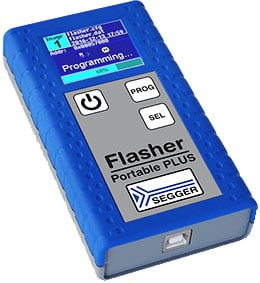Flasher Portable PLUS
Flasher Portable PLUS
The Mobile Flash Programmer
The handheld stand-alone Flash Programmer for on-chip and external flash memory. Flasher Portable PLUS is a battery driven programming tool for microcontrollers with on-chip and/or external flash memory. It has been designed to fill the need of an extremely portable, production grade flash programmer used for in-field firmware updates.

Features
- Stand-alone in-circuit-programmer (Once set up, Flasher can be controlled without the use of a PC program)
- Powered by internal battery rechargeable Li-Ion 680mAh, no external power supply required
- Full insights with the new 1,8 inch display
- Up to 10 hours programming with one battery charge
- Supports having up to eight configurations/data files being stored on Flasher
- Push button allows easy selection between multiple images/configurations stored on Flasher
- 128 MB internal memory for configuration and data file storage
- Supports ARM, Cortex, PowerPC and Renesas RX cores.
- Supports internal and external flash devices
- Free updates
- Data files can be updated via mass storage or via J-Flash
- Target interface: JTAG / SWD / FINE / SPD
- Programming speed typically between 30 KB/second and 1 MByte/second. Max. programming speed highly depends on target hardware and max. programming speed of the flash itself
- SECURITY: Flasher Portable and Flasher Portable PLUS support Authorized Flashing. It allows to limit the number of flash programming cycles and to protect the Flasher against non-authorized access in case of external production
Flasher Portable PLUS can be powered by its internal rechargeable battery or USB. Use the integrated 1,8 inch display to review your firmware and programming status.
Initial setup/preparation for stand-alone mode operation is done via the J-Flash software, also used by other Flasher models, which requires a PC running Microsoft Windows 2000, Windows XP, Windows 2003, Windows Vista, Windows 7, Windows 8 or Windows 10.
Flasher Portable PLUS also supports having up to eight configurations/image files stored on the Flasher, so one unit can be used for different targets, versions or configurations. Proper image selection is done by simply clicking a button. The currently selected image is displayed.
Isolators to optically isolate the Flasher Portable PLUS from Power Supply or the target and adapters for all common connectors are available for the Flasher Portable PLUS.
Working with Flasher
Flasher can be used for programming flash targets with the J-Flash software or stand-alone.
Setting up Flasher for First Use
In order to use Flasher for the first time you need to install the Flasher related software and documentation pack which, among others, includes the J-Flash software and connect Flasher to the host PC via USB.
Power-On Sequence
In general, Flasher should be powered on before connecting it with the target device. That means you should first connect Flasher with the host system via USB / RS232 and then connect Flasher with the target device via JTAG. Power-on the device after you connected Flasher to it. If you use Flasher in stand-alone mode, just power-on Flasher via external power supply.
Verifying target device connection with J-Link Commander
If the USB driver is working properly and your Flasher is connected with the host system, you may connect Flasher to your target hardware. Then start the J-Link command line tool JLink.exe, which should now display the normal Flasher related information and in addition to that it should report that it found a JTAG target and the target’s core ID. The screenshot below shows the output of JLink.exe. As can be seen, it reports a Flasher with 3 JTAG devices connected.
Verifying target device connection with J-Flash
Another way to verify the target connection is to connect to the target using J-Flash. To connect to the target with J-Flash you have to choose an appropriate project file for the target first. After opening the project file choose Target –> Connect from the menu to connect to the target. If everything works as expected, follow the instructions in 2.2 to download a program to Flasher with J-Flash.
Supported Devices
Flasher Portable PLUS supports a wide range of CPU cores and an even wider range of different devices from various vendors. On this page, an overview of all supported CPU cores as well as devices for which flash programming is supported is given.
Supported CPU Cores
Any microcontroller, MPU, SoC with a supported CPU core with its debug interface accessible is supported and can be controlled by Flasher Portable.
Universal Flash Loader
Besides programming the flash memory via the debug interface (JTAG), there are some devices which are programmed via a device-specific programming interface. These interfaces can be supported by the Universal Flash Loader, a feature for the Flasher PRO and the Flasher Portable PLUS. The Universal Flash Loader supports the serial programming interface of the Renesas RL78 device family, based on a 16 bit microcontroller including over 1000 devices.
